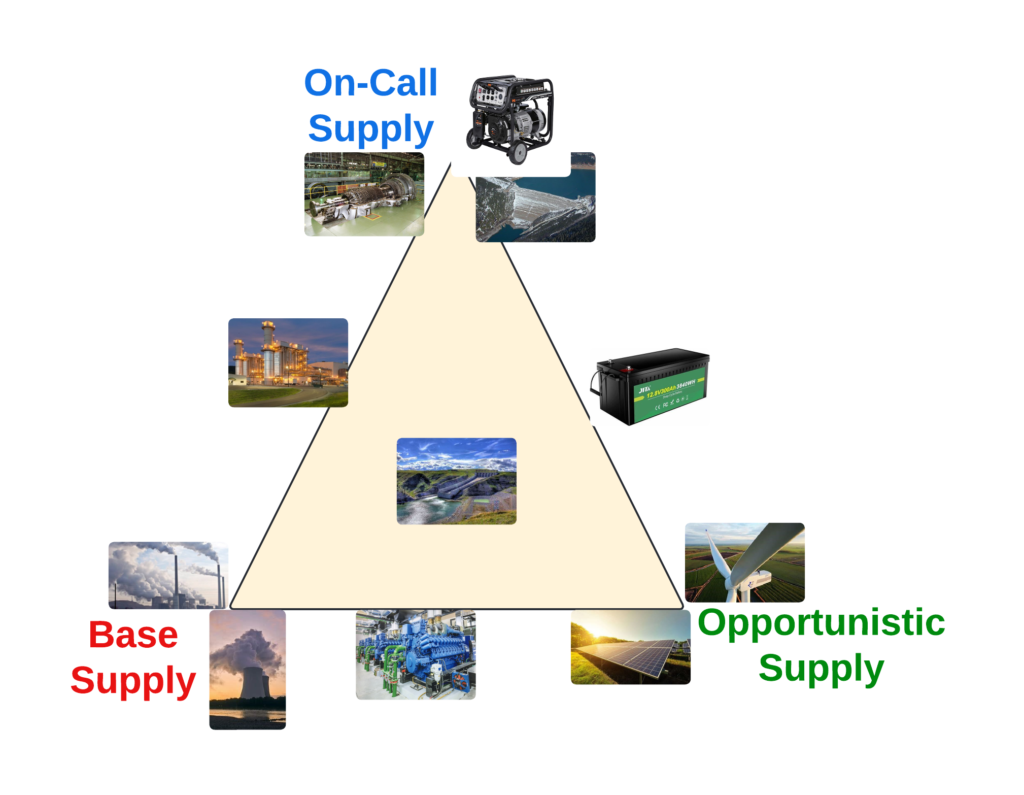Abstract
We classify power generation based on the source: fossil fuel or renewable. However, we can also classify power generation by the role it plays in supply and demand. This tells us something important.
YouTube Video
Introduction
There are many was to generate electricity for the power grid. Some places use only one type. For example, the province of British Columbia uses hydroelectric generators. Alberta has almost everything, except for tidal and nuclear. We usually think of power generation sources as renewable or non renewable, but lets do this differently. We know that power supply must match power demand. We will classify power sources by how they fit into the Supply = Demand equation. From this, we will see which type of power generation is most important for keeping our power grid stable and our lights on.
Classifications
The supply of electrical power must always equal the demand, otherwise we get power outages or overloads. We will define three different types of power generation.

- Base Supply. These are large sources that take a huge bite out of the demand, but these sources do not change rates very well. They provide a consistent amount of power.
- Opportunistic Supply. You get what you get, and you don’t get upset.
- On-Call supply. Think of this as Backup. This helps out when needed to ensure supply matches demand. These are the important sources.
Now we can describe different power sources by these different types.
- Nuclear. Classic base supply. Big. They do not change rates very much. We don’t have any nuclear in Alberta, yet.
- Coal. Another base supply. Our last coal fired plant should be converted to natural gas in a few months.
- Solar. Classic Opportunistic. We only get power when the sun shines.
- Wind. Another opportunistic example. We only get power when the wind blows. We will look at the reliability of wind in a future video.
- Gas Genset. Simple example of On-call. If you need more power, fire up the generator.
- Combined Cycle Gas Turbine.. About half the emissions compared to coal. We can make slow, deliberate changes over the year or a day, but not over an hour. I put this one between base and on-call.
- Simple Cycle Gas Turbine and simple boilers. We can adjust these over an hour. This our go-to to ensure supply matches demand. These sources are less efficient than CCGT, and cost more to produce power. This is definitely On-Call.
- Large Hydro. These are huge power sources, but they are also flexible. This is how BC ensures supply matches demand. This goes in the On-Call category.
- Small Hydro. This is interesting. Has some base capacity, it is opportunistic over the year, and we can tweak the output over an hour.
- Cogeneration. This is opportunistic because power generation depends on an industrial process that requires heat. But we have a bunch of these and the operation of each facility is not correlated to each other. These behave like base load. I like cogeneration. Get the most value from natural gas, waste nothing.
- Battery Storage. At first glance we say this is On-call, but this is also Opportunistic because we need to charge the battery and we have a limited supply when charged. This deserves an separate blog.

Summary
We need On-Call power to ensure our grid is stable. This is the most important category.
If we have large scale hydroelectric generation then we are fine. There is no need for anything else. Why would we spend money on wind or solar when we need sufficient hydro capacity to meet our peak demand anyways? This is a rhetorical question.
If we consume fossil fuels to generate power, then we need more renewable sources to reduce fuel consumption. This means we also need to support inexpensive On-Call SCGT or boiler power plants to keep our lights on when the wind is not blowing or the sun is not shining.







